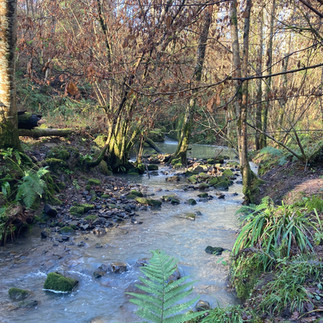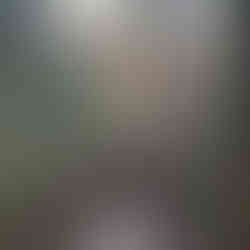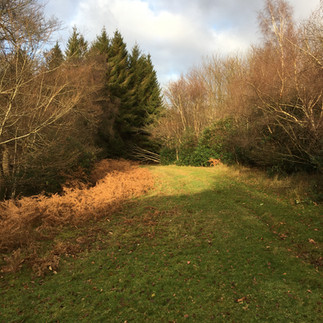
The new moon hangs like an ivory bugle
In the naked frosty blue:
And the ghylls of the forest, already blackened
By winter, are blackened anew.
The brooks that cut up and increase the forest
As if they had never known
The sun, are roaring with black hollow voices
Betwixt rage and moan
But still the caravan-hut by the hollies
Like a kingfisher gleams between:
Round the mossed old hearths of the charcoal-burners
First primroses ask to be seen.
The charcoal-burners are black, but their linen
Blows white on the line;
And white the letter the girl is reading
Under the crescent fine;
And her brother who hides apart in a thicket,
Slowly and surely playing
On a whistle an old nursery melody
Says far more than I am saying.
Edward Thomas wrote The Penny Whistle on 5th January 1915 when he had just sprained his ankle badly and was laid up at home in Steep. During the next few weeks while he remained immobilised he wrote many of his early poems drawing on memories and jottings from his Field Note Books. The Penny Whistle drew on notes in FNBs 62, 67 & 69 which he wrote while staying with a poet and a friend, Vivian Locke Ellis and his wife at Selsfield House, Turner's Hill near East Grinstead during 1913. Overall that year he stayed with them for several months on four separate occasions so he could concentrate on his writing away from family distractions. His FNBs show ET spent many of his days there exploring round Selsfield and further afield across Ashdown Forest and other parts of West Sussex.

The Penny Whistle was inspired by what seems to have been a particular favourite walk where he encountered the charcoal-burners in their semi-permanent camp in the woods at the conjunction of valleys south of Selsfield House. He made notes about passing the camp four times, once in May and three times in December 1913. Unlike some of his longer walks here, he could easily do it after a day's writing to stretch his legs in the winter's dusk (a mere 4 or 5 miles).

The first time he encountered the charcoal-burners was in early May, very different from the December evening he described in the poem. Bluebells covered the woods in swathes, with primroses, violets and cuckoo flower "all over" the roadside. Besides a cursory visit by bike in the summer of 1912, it was his first visit and his first proper sight of the countryside round Selsfield House. He noted "Woods up and down ridge after ridge for 5 or 6 m(iles) in every direction, all in leaf."
There are two entries for 3rd May - the first briefly mentioned "the rocky Ghyll" directly below Selsfield House which he noted as being the source of the Ouse, its valley full of mossy woods, primarily oak and bluebells. A ghyll is the name for a brook in a deep, steep-sided valley of sand and clay, running off Ashdown Forest - normally wooded. They are numerous and most are named but the one from Selsfield House is simply known as The Ghyll. It gained especial prominence for ET at the end of that year, when early one morning after a day and night of increasing rain he heard its springs burst out with a great noise "like a giant having a bath", the origin of his poem The Source. In his May note he also jotted down "charcoal-burners caravan of blue smoke by wet old road in woods".
His next entry for 3rd May is far more extensive, describing the circular walk in detail including encountering the caravan of the charcoal-burners, semi-itinerant people whose way of life, like the gypsies, fascinated him. Whether he did two walks that day, or the second note just fleshed out the first or (less likely) he had wrongly dated one of the entries, is unclear.
The walk took the footpath opposite Selsfield Common on the road to Turners Hill, across high grassy fields to Great Strudgate Farm and then the lane to Newhouse Farm, passing copses and further down on the right the more extensive woods of Paddockhurst Park.
He followed the road down to the valley bottom and took a left along "a cart track above a deep cut rushing rivulet". The track went high along the valley slope through oak woods, with bluebells, and below, by the stream, beds of marigolds. He began to see signs of the charcoal-burners - piles of bark and cordwood and oaks "peeled pale". There were "several black level floors on slope where charcoal had been burnt." One had a "tent-shaped" hut of boughs covered with turf and with a pointed doorway (which he sketched). Soon he arrived at the junction of the stream he had been following and the Ghyll or Selsfield stream. Here at the bottom he saw the "magic-blue van" of the charcoal-burners. It was hoisted up on a platform of posts (well above the wet boggy ground beneath). He was intrigued by the blue of the caravan which he noted as being "vy strange bright, almost electric blue" - later in December he described it as "smoke-blue", as previously, and in the poem it became "like a kingfisher". He also thought he saw another bigger turf-coloured hut, though it could have just been a large stack of wood.

He walked back to Selsfield above the Ghyll along bluebell paths through oak woods with some hazel undergrowth, under the occasional exposed outcrop of sandstone. He noted "these little meeting valleys very deep & steep."
In that first walk he did not meet any charcoal-burners. But in December he had two encounters from which the poem stemmed. He had been back and forth between Selsfield, Steep and London for much of that year with forays to Broughton Gifford for the annual cricket match organised by Clifford Bax and a holiday with his son Mervyn and his friend Eleanor Farjeon on Ranworth Broad. Returning to Selsfield in November after increasing depression and dissatisfaction with family life, he had taken up semi-permanent residence there. Though he was writing during his stay, his field note books attest that he spent much of his time exploring the neighbourhood and further afield.
The first encounter with charcoal-burners was on 5th December after a windy night and a fine day with thrushes singing. He was walking through the woods in a deep hollow valley and came across a boy by a blue hut piping slowly a bright old country tune, making it melancholic and bird like. Afterwards he walked on to The Warren, another large wood west towards Balcombe, and he would probably have walked back to Selsfield House the opposite way to his May walk via Newhouse Farm and Old Strudgate and then through the fields above Selsfield (in which he noted one stalk of ragwort flowering and some hedges being trimmed).
Four days later, after a mild, windy and dull day with some gentle rain beginning at nightfall, he returned to the same woods above the stream, passing by charcoal burners filling sacks. The rows of sacks were "like headless little cloaked men" and circular terraces "beginning to be mossy" were where the charcoal-burners had their hearths to burn the wood. This time two "hatless" girls were talking outside the blue hut - "the men being away probably". One was reading a letter for comment - he caught "I remain affectionately yours" then silence and more talk but inaudible.
He walked back to Selsfield by the Ghyll, winding by timber paths above the stream,
with oak and hazel - under bigger oaks on either side of vale. As he had started on his return from the camp up the Ghyll he could see "half way up far side" grass fields "one with brown bracken lying in rows on slope". This was Bloomer's Valley, an ancient meadow and part of the Wakehurst Estate.
On his walk he had noted wood pigeons, a goldfinch and a wren. As he arrived back at the house at 4.15 the ubiquitous thrush stopped singing "as rain comes".
Then on 27th December after a difficult Christmas when his family had come to stay at Selsfield they went on a family walk through woods close to the charcoal burners and found the first primroses mentioned in the poem. As with other early flowers, his eldest daughter Bronwen was the first to find them.
So the four visits to the charcoal-burners' caravan-hut provided all of the elements of the poem - the ghylls of the forest, a boy piping a nursery melody, the girl reading the letter, the first primroses, the charcoal-burners and the remnants of charcoal-burning in the woods. On 5th December, the day he heard the boy piping, the moon was moving from crescent into the first quarter.
The woods he walked through were part of the very substantial Paddockhurst Estate, which had been bought by the very successful businessman and politician, Weetman Dickinson Pearson, later Viscount Cowdray in the 1890s. It was his seat until after he bought Cowdray, near Midhurst in the early 1900s. The house of Paddockhurst was sold and became Worth school in the 1920s. The estate was and is an extensive one, originally of c5000 acres with many tenant farms including Newhouse and the Strudgates.
The sound and sight of people living in these wild deep hollow valleys on a winter's eve must have been very evocative and clearly memorable for ET as he drew on it for one of his earliest poems. Charcoal-burners would come from nearby villages or towns to work and live in the woods for the season. They would often bring their families as seems to be the case here. Burning would tend to occur after the wood cutting season (between May and October) and would normally be completed by the end of the year, so ET was probably seeing the final burnings and a tidying up operation.
A Walk

The countryside to the west of Selsfield remains untouched and much as ET would recognise. It has rolling views across high fields and deep valleys with forests of fir and oak on the ridges to Haywards Heath and beyond in the distance the dim line of the South Downs. ET regularly described this view and the different skies and atmospheric conditions that prevailed throughout his stay. He was clearly intrigued by the countryside, very different from Hampshire, where the broad valley of the Rother and the long escarpment of the South Downs dominated the view from his study and there was often a patchwork of light and shade at play. Here the countryside had a mixture of big views and skies with more sombre dark woods cladding the sequence of ridges and deep valleys. In an entry to one of the FNBs when he was describing an extreme depressive phase he had experienced in December, he wrote of a "hollowed wooded country nothing but gradations of inhuman dark...as of an underworld & my soul fled over it experiencing the afterdeath - friendless, vacant & hopeless." He was to use this imagery in his poem, The Gypsy, which he drafted shortly after The Penny Whistle.
The layout of Paddockhurst has also remained pretty much unchanged since the 19th century with a wide range of trees including oak, birch, fir, lime. yew and some more exotic specimens. The valleys of the ghylls, still clad in oak woods, do cut up and increase the forest as ET described, which anyone walking across a few of them laterally will discover soon enough.
ET's walk from Selsfield House can still be followed but involves going through the private woods of Paddockhurst Park. There is a more extended walk along footpaths and lanes which touches on key points of his walk including the location of the caravan hut. It gives a good feel to the character of the countryside.
The walk starts from Selsfield common where it's possible to park. A quick diversion to the north of the common provides a good view of the North Downs, much nearer and clearer than the South Downs.

Crossing the busy road going south you follow the footpath across the high fields which give distant views of the South Downs and the ridges in between. You follow the same route as ET did down past the farms of Great Strudgate and Newhouse to the valley bottom. Here instead of following the cart track you carry on along the road passing over a dam with its precipitous slope down to the rivulet that ET followed. On the right is a lake, which has been extended since ET's day, curving up under slopes of oak and beech trees. Climbing the road past Little Strudgate Farm you reach the crossroads of Back Lane, Paddockhurst Lane and Stony Lane (where there is an alternative place to park a car).

Walking left up Paddockhurst Lane, after a 1/4 a mile or so you take the footpath left past a house and garden (the Oaks), opposite the entrance to Forest Farm. Crossing these fields there are excellent views of the Ghyll valley and the grounds of Wakehurst Place and the ridge of the Ardingly road beyond. Following the path round the field you enter Fire Wood and then go steeply down the rocky and muddy path to Horse Bridge close to where the two streams join to become the Ardingly Brook.
After the bridge the path turns 90 degrees to the right - to the left there is an old path which was probably the cart track ET followed from the road below Newhouse Farm. Here in the damp and muddy valley bottom there are two holly trees whose predecessors may have been the hollies between which the caravan on its platform gleamed. To the left of the path, a big dyke cuts across the Gyhll. Beyond and above it are the paths ET would have headed back on to Selsfield House from Horsebridge wood, through the woods of Littlebushy, Church and Sheepwash. Up to the right as you look up this valley you can see Bloomer's Valley, the meadow ET could see, now a landmark meadow restoration by the Royal Botanic Gardens.
The footpath takes you out of the valley through a gate into the grounds of Wakehurst Place, close to Bloomer's Valley. You follow the footpath signs up to a field and past Wakehurst Place and the Royal Botanic Gardens Millennium Seed Bank. Before reaching the road you take a path to the left which goes straight through a wood and field back down into the Ghyll reaching another bridge in Sheepwash wood and crossing ET's path again. Going over the stream you climb steeply out of the valley past sandstone outcrops. Walking along the north side of Bushycroft Wood you reach the road by Newhouse Farm and you retrace your steps back to Selsfield Common via Great Strudgate and the high fields.

Maps, coordinates, acknowledgements
Maps: OS Explorer 135 Ashdown Forest
Selsfield Common - Grid Reference: TQ348345 (OS Map)
Wakehurst Place:
Field Note Books copyright Henry W. and Albert A. Berg Collection, New York
My thanks to Ben Mackay for his editorial support.





































Comentarios